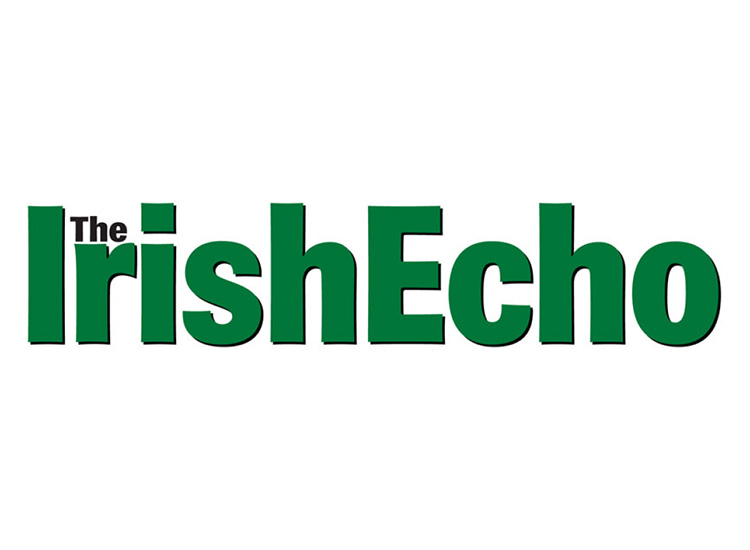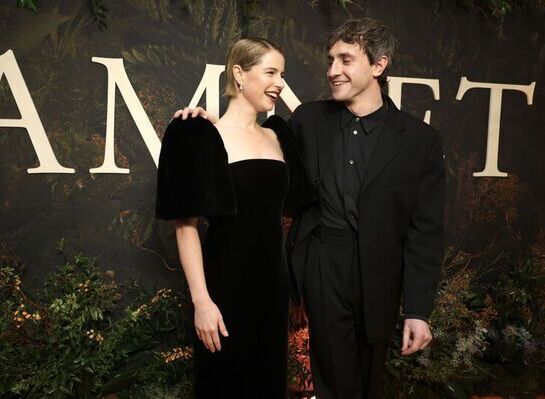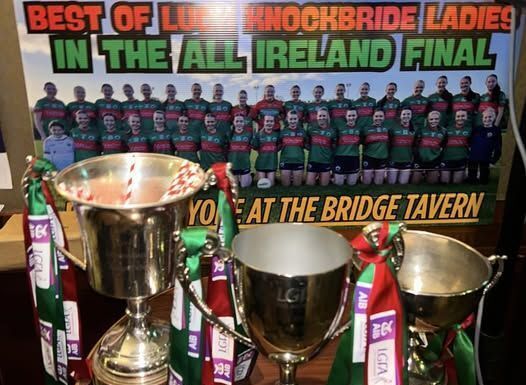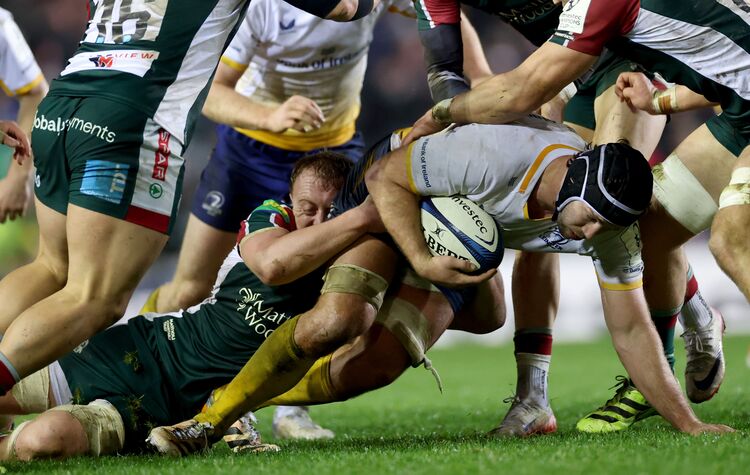Tommy Tiernan, right, and Mike McCormack in “Cumar: A Galway Rhapsody.”
By Peter McDermott
To sustain a living in the arts involves “risk and danger, at least in Ireland” -- it takes “bravery and energy.”
That’s according to Aodh Ó Coileáin, director of “Cumar: A Galway Rhapsody” a documentary that will get its New York premiere on Friday night as part of this year’s Craic Fest.
He paraphrased the viewpoint of one of six profiled in the film, Mike McCormack, winner of the 2018 International Dublin Literary Award for the novel "Solar Bones," when it was suggested that his son might follow in his footsteps as a writer: “Not if I can help it. I’ve gone through hard, lean years myself so I wouldn’t want him to go through the same.”
“Cumar” has a few meanings in the Irish language, but one in particular speaks to that issue.
Ó Coileáin recalled that there was a river in front of his grandfather’s farmhouse near Killarney, Co. Kerry, and one had to walk over a bridge to get to the outside world. There was a stony decline on the river’s edges and his grandfather warned young people against going near the “cumar.”
“Even though he was English-speaking, the word had survived,” the grandson said.
“If you fell in it would be ‘the finish of you.’”
“Working in the arts is like being on the edge,” Ó Coileáin said.
A related meaning is a deep ravine; another, with perhaps more local resonance is a confluence, where waters meet, as with the Corrib River and Galway Bay.
“We attached our own meanings,” he added. Another of the film’s subjects, the Connemara native and visual artist Pádraic Reaney, speaks of the “effect of a place on the human heart.”
“So we took that as a definition of cumar,” the director said.
So, what explains Galway's particular identification with the arts? Partly, Ó Coileáin believes, it can be traced to its status as a Norman city from the 13th century onwards and as the Irish trading port favored later by both the Spanish and the French.
“And, in recent years you’ve had people from all over the world coming into Galway and adding character to the ancient City of the Tribes,” he said.
Those most prominently associated with the city’s arts scene in the 20th and early 21st centuries have tended, though, to come from nearby; as in the case of late playwright Tom Murphy, who was from near Tuam. Co. Galway.
Hymn to student life
His works were staged in the city’s Druid Theatre Company, which was founded in 1975 by Garry Hynes, Marie Mullen and Mick Lally, who were respectively from Counties Roscommon, Sligo and Mayo. The novelist McCormack, a Galway resident, comes from Louisburgh, Co. Mayo, and future TD, minister for arts and now President Michael D. Higgins, was raised on a farm in County Clare. Winning a place to study at University College Galway, later renamed National University of Ireland, Galway, was the initial reason those five went to live in the city, as it was in Ó Coileáin's case.
McCormack's experiences at UCG in the 1980s were the inspiration for an early novel “Crowe’s Requiem,” (1998). “It's a hymn to student life. It beautifully describes the city, the streets, the canals, the sea, the pubs,” Ó Coileáin said. “He really gets it.”
"Cumar" from the beginning was an abstraction, the director said, an “intellectualization that needed images and that needed sounds to put flesh and blood on the bones.”
His profiled subjects helped with that. Among the others are sean-nós singer Róisín Seoighe, who though from Connemara “represents the link with the Irish-speaking parts of the city,” poet Rita Ann Higgins, who writes mainly in English, but is on a "real quest for her roots," he said, because her father who was from Connemara would not speak Irish in the city, the artist Reaney and musician Máirtín O’Connor.
Ó Coileáin conceded that it wasn’t easy to find a structure to fit six profiles, but there was an obvious storyline around one of them – the effort to put on the 2018 Macnas Halloween Parade, as seen through the eyes of its artistic director Noeline Kavanagh.
Ó Coileáin’s own Galway story began in earnest the year the annual Macnas parade debuted, 1986, when he enrolled as a first-year student at UCG. But there was an earlier trip to the city when he was 13, with a traveling group from County Kerry.
“I was selected to join Siamsa Tíre [the National Folk Theatre of Ireland] based in Tralee. The company had played for a week in the Palace Theatre on Broadway in 1976, before my time. [New York Times critic] Clive Barnes, the so-called 'Butcher of Broadway,' said: ‘Absolutely superb...it made me want to catch the next plane to Ireland.’”
If Galway was similarly impressed with Siamsa Tíre, the young Ó Coileáin was for his part quite taken on that first trip with the National Irish Language Theatre, An Taibhdhearc, which has been based in Galway since 1928. These days, he is its chairperson.
Also still going strong, he reported, are Aisteoirí Bhréanainn, a local troupe of actors he joined in the West Kerry Gaeltacht in 1976 as a 9-year-old.
“I learnt a lot about stage craft, design and theatre lighting,” he said about those early experiences.
At UCG, Ó Coileáin became a founder member in 1987 of Na Fánaithe [Irish for “the Wanderers”] – a professional theatre company that toured Ireland through 1993. It represented Ireland in August 1992 at the World Fair, Expo '92, in Seville to mark the 500th anniversary of Christopher Columbus's voyage to the New World.
“All these experiences,” he said, “shaped this film.”
A television career began with his being trained as a producer-director in Irish-language broadcasting from 1989, and he became a news editor when TG4 started up in 1996 and worked there for seven years.
At the turn of the millennium, Ó Coileáin began another career as a maker of film documentaries, work that has taken him all over Europe, Asia, Africa and the Americas. An early effort in 2001 put him on the map — it told the story of the health-care system in Cuba and the personal links between some of its doctors and doctors back home in Ireland. Since then, he has made a documentary at the rate of one for every two or three years.
“Cumar,” which premiered at last summer’s Galway International Film Fleadh, is a timely project, given that the city and the surrounding county is European Capital of Culture for 2020. It played to a capacity audience of 400 people in the American Film Institute Silver, Washington DC, on March 1, as part of the 14th Capital Irish Film Festival, and will transfer to the Newport Beach Film Festival, Calif., in April.
Playing somewhat the role of contrarian as an onscreen commentator is County Donegal-born comedian and UCG graduate Tommy Tiernan, who says: “Galway as a city for the arts is not something bone-deep in Mervue and Renmore and Ballybane.”
Ó Coileáin believes that argument has some merit. But he said any city in the Western world known for the arts, including New York, has to ask itself if its young people or its working-class people have the time or the disposable income to buy tickets for cultural events.
He said that poet Rita Ann Higgins, who draws much of her “inspiration for her work from working-class Galway,” grew up in Mervue; and he added that Macnas’ director Kavanagh is from Renmore.
Ó Coileáin stressed the importance of public funding for the arts. “You have to spend money to get money in,” he said.
During the recent general election, an arts group sent the various parties a question: Would they support the aim of bringing government spending on the arts up to parity with other EU countries by 2025?
Fine Gael, the Green Party, the Social Democrats, Labour and People Before Profit said yes, but Fianna Fáil and Sinn Féin (which would get almost half the seats and first-preference votes between them) said no.
Need for a plan
“When you come out of Ireland and you go to London, to New York, to Boston, to Washington, to Chicago, all over North America, you see the hunger that is there for Irish culture — for Irish film, for Irish theatre, for Irish music, for the Irish language, for Irish music," Ó Coileáin said.
"The government needs to take that more on board. Culture Ireland is doing great work, the Arts Council is doing good work but more money is needed for the Irish language, to get more people writing, more training, to get more writers, directors; otherwise, the scene will not be as strong as it could be in that you won’t have enough new blood coming through," he said. "If people don’t see you can make a living they won’t do it. There needs to be more planning."
Arts funding is not a non-essential ingredient, like the nicely-sculpted icing atop the cake, in Ó Coileáin view. It's as important as that allocated for education or physical infrastructure.
"The arts are good for the health of society and for the empowerment of community, and for us as a nation to express ourselves to ourselves and to the rest of the world," he said.
Galway has had a model in the man, now president, who as part of two consecutive administrations from January 1993 through July 1997, was minister for Arts, Culture and the Gaeltacht and that term is considered one of the most most successful by a minister in the history of the state.
"People thought of Michael D. as a poet, an orator, a philosopher," Ó Coileáin recalled, "and one politician said that he would 'go mad in power.'
"But he did more for Galway, for the arts, for the film industry, for television, than anybody has done before or since, or maybe the people before or since combined," he said of Higgins's tenure. "He achieved a lot. He really defied his critics. He really proved what I am trying to prove in this film — that it’s all about rolling your sleeves up and getting your hands dirty.”
"Cumar: A Galway Rhapsody" will be screened on Friday evening at Cinepolis Theater, 260 West 23rd St., NYC, at 7 p.m. Go to thecraicfest.com for details.








